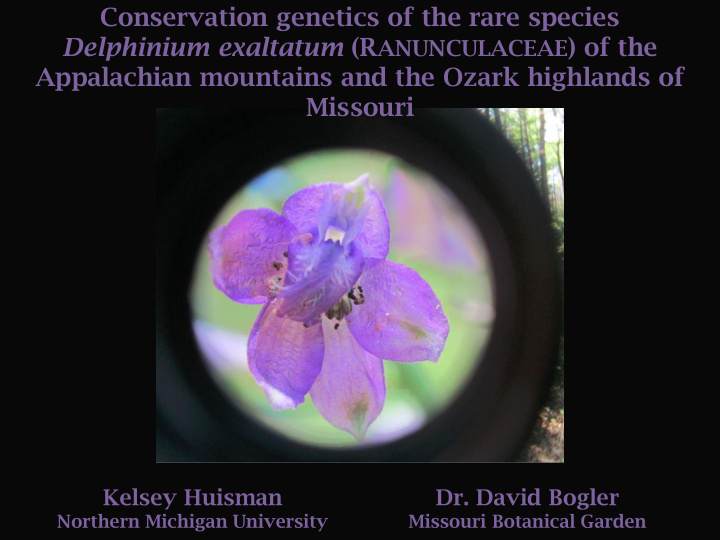



Conservation genetics of the rare species Delphinium exaltatum (R ANUNCULACEAE ) of the Appalachian mountains and the Ozark highlands of Missouri Kelsey Huisman Dr. David Bogler Northern Michigan University Missouri Botanical Garden
I NTRODUCTION
objective Examine the genetic variation and differentiation within and among populations of D. exaltatum from the Appalachian mountains and the Ozark highlands of Missouri to distinguish the effects of geographic isolation.
M ETHODS
study sites
• Habitat – Dolomite glades with alkaline soils – An average of 65% shade • Height is between 4 – 6 feet, – Primarily found on southwest to • Individual and at times taller northwest facing slopes flowers are • Cauline • Associated plant species radially life cycle symmetrical • Petiolate – >85% Chinkapin oak ( Quercus with five sepals muehlenbergii ) • April-July: Vegetative • Deeply lobed – Hairy angelica ( Angelica venenosa ) • July-September: Flowering • One of the • August-October: Fruit • Encroaching plant species sepals creates a • Mid to late November-March: Dormant – Cedar ( Juniperus virginiana ) spur – Sugar maple ( Acer saccharum ) • Raceme of 8-30 blue to purple flowers
extractions
amplification
1st PCR cycle
gel-stab technique
2nd PCR cycle
sequencing • Yale University – DNA Analysis Facility • Sanger sequencing Missouri, Howell County sample 11 – large band, forward sequence
R ESULTS
Figure 1. Likelihood analysis. Missouri populations are shown in green.
D ISCUSSION
A CKNOWLEDGEMENTS • National Science Foundation • National Park Service – Daniel Drees – Christine Steinwand • Missouri Botanical Garden – Dr. David Bogler – Justin Zweck – Dr. Rosa Ortiz-Gentry – Missouri Botanical Garden Staff • REU Students
Questions?!
Recommend
More recommend